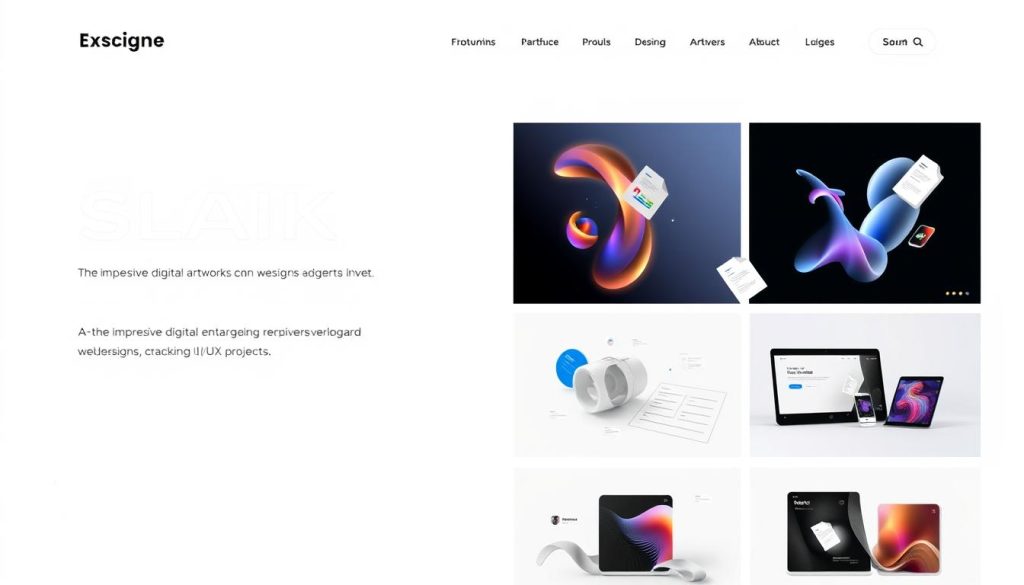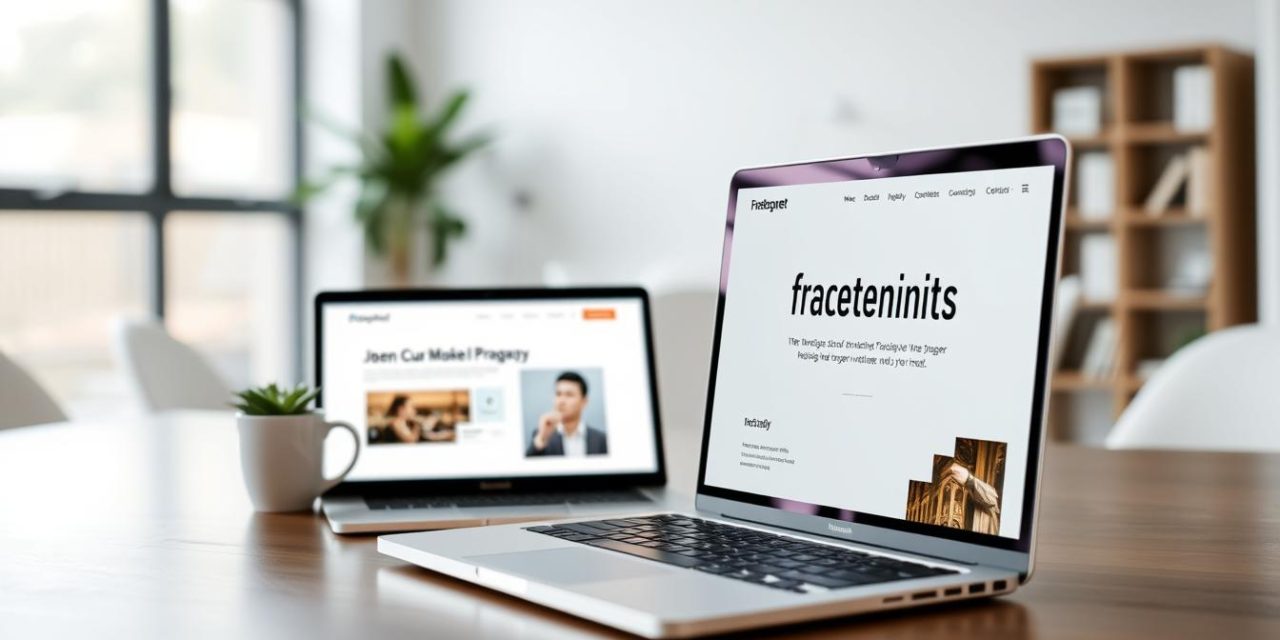Remember the excitement of landing your first client? That rush of independence fuels over 3.3 million French professionals who’ve embraced freelancing since 2023. What started as a side hustle has become a movement reshaping careers and businesses alike.
France’s freelance economy exploded by 92% in just over a decade. Companies now actively seek talent through digital platforms rather than traditional networks. Your online presence isn’t just helpful – it’s your most powerful business tool.
A polished portfolio site builds instant credibility. It filters out low-value inquiries while attracting clients willing to pay premium rates. Think of it as your 24/7 brand ambassador, showcasing your skills even while you sleep.
Many believe creating professional sites requires coding expertise or large budgets. We’ll show how modern web design tools let anyone craft stunning, functional spaces that convert visitors into long-term partners.
Table of Contents
Key Takeaways
- France’s freelance workforce grew 92% since 2009, demanding stronger digital visibility
- Professional sites attract higher-quality clients and justify premium pricing
- Businesses increasingly source talent through online portfolios versus referrals
- Clear navigation and project showcases outperform cluttered personal pages
- Modern tools enable polished web design without technical expertise
Understanding the Growing Freelance Economy in France
Three-point-three million professionals now shape France’s freelance landscape – a workforce larger than Paris’ entire population. This 92% surge since 2009 reveals more than temporary trends; it signals a permanent shift in how businesses access talent and professionals design careers.
Decoding the Numbers Behind the Movement
Technology fuels this transformation. Cloud platforms enable work remotely arrangements, while AI tools help freelancers manage multiple clients efficiently. Companies now outsource 37% more projects than five years ago, particularly in IT and creative sectors.
The New Professional Currency: Flexibility
Workers prioritize autonomy over stability – 68% cite control over schedules as their top motivator. Businesses gain too: 42% report cost savings through targeted freelance missions versus maintaining full-time teams.
This symbiotic relationship reshapes industries. Marketing agencies now blend core staff with specialized contractors, while startups use freelance developers to scale rapidly. The result? A dynamic economy where skills flow to opportunities faster than ever.
Clarifying Your Vision: What Makes a Professional Site?
What separates a forgettable online page from a client-winning professional platform? The answer lies in strategic design choices that blend aesthetics with purpose. Top-performing portfolios use color contrasts and typography to guide visitors’ eyes to key services, creating instant recognition of your expertise.
Effective sites communicate value within 3 seconds. A crisp headline stating your specialty – like “UI/UX Designer for Fintech Startups” – outperforms vague titles. Pair this with authentic project images rather than generic stock photos. Clients trust real work samples 73% more than staged visuals, according to recent design surveys.
Three technical standards non-negotiables:
- Mobile-responsive layouts adapting to all screen sizes
- Page speeds under 2 seconds to prevent bounce rates
- Clear contact paths with service-specific inquiry forms
Successful portfolios balance creativity with client needs. A graphic designer might use bold animations but keeps navigation intuitive. Developers often opt for clean interfaces with interactive code demos. For actionable steps, explore this step-by-step guide for building your digital.
Your site’s professionalism directly impacts perceived rates. A Stanford study found well-structured portfolios justify 22% higher pricing by showcasing specialized skills. Every element – from button placements to project case studies – should reinforce why clients choose you over competitors.
Essential Features for a Successful Freelance Website
High-performing digital platforms share common elements that convert visitors into collaborators. These components work together to showcase expertise while simplifying client decision-making.
Key Design Elements and Tools
Effective service pages act as your virtual sales team. Clearly outline your offerings using client-centric language like « I help [target audience] achieve [specific outcome]. » Include pricing tiers that match market expectations while highlighting premium options.
Advanced features separate professional platforms from basic sites. Client portals with project tracking increase transparency, while password-protected galleries let you control content access. Testimonial systems that display client logos build instant credibility.
| Feature | Basic Version | Advanced Implementation |
|---|---|---|
| Navigation | Standard menu | AI-powered search with service filters |
| Portfolio Display | Image gallery | Interactive case studies with metrics |
| Contact Options | Email form | Integrated calendar booking + video call scheduler |
Security remains critical for protecting sensitive data. SSL encryption and GDPR-compliant hosting should be standard. For those seeking expert design strategies, focus on platforms offering automatic updates and backup systems.
Analytics integration transforms guesswork into strategy. Track which services attract the most attention or which portfolio pieces drive inquiries. These insights help refine your offerings over time.
Choosing the Right Web Design and Layout

Your digital space’s visual framework determines how clients perceive your expertise. Strategic layout choices create immediate trust while guiding visitors toward meaningful actions. Let’s explore techniques that balance aesthetics with functionality.
Responsive and Intuitive Design Tips
Modern users access content across smartphones, tablets, and desktops. Implement these mobile-first strategies:
- Use flexible grid layouts that adapt to any screen size
- Prioritize touch-friendly buttons (minimum 44px size)
- Test loading speeds across French mobile networks
Navigation patterns should feel instinctive. Place primary menus in standard locations and limit dropdown options to seven items. Breadcrumb trails help users retrace steps without frustration.
User Experience Optimization Strategies
Reduce bounce rates by aligning visual hierarchy with client priorities. Place service highlights above the fold using contrasting colors. Case studies show proper spacing between elements increases engagement by 38%.
Consider these accessibility enhancements:
- Alt text for all portfolio images
- Keyboard-navigable interfaces
- Color contrast ratios exceeding 4.5:1
Typography choices impact readability and brand perception. Sans-serif fonts like Arial work well for digital interfaces, while serif typefaces convey tradition in fields like legal or finance. Pair fonts intentionally – limit combinations to two styles maximum.
How to Build Your Freelance Website Step-by-Step
Transforming your skills into a professional online space follows three critical phases: strategic planning, precise execution, and continuous refinement. This roadmap helps avoid costly missteps while aligning your digital presence with business goals.
Planning, Wireframing, and Development
Start by defining your core objectives. What client actions matter most? Contact forms? Service inquiries? Map user journeys using tools like Figma or Adobe XD. These platforms let you visualize page layouts before writing code.
Wireframes act as blueprints. They establish content hierarchy and navigation flow. Prioritize essential elements:
- Service showcases above the fold
- Clear call-to-action buttons
- Mobile-optimized menus
Choose development paths matching your technical comfort. Beginners might use Squarespace’s drag-and-drop editor, while those needing custom solutions could explore web development strategies from coding professionals.
Launch and Post-Launch Considerations
Pre-launch testing prevents embarrassing glitches. Check forms across browsers and simulate mobile interactions. Tools like Google Lighthouse analyze loading speeds and accessibility compliance.
Post-launch, monitor these metrics weekly:
- Page load times under 2.5 seconds
- Bounce rates below 40%
- Conversion rates per service page
“Your site isn’t a finished product—it’s a living portfolio,” notes Marie Dubois, a Paris-based UX designer. Schedule quarterly updates to refresh content and security protocols, ensuring your platform evolves with market demands.
freelance website: Best Practices for Visibility and Functionality
How does your digital space perform when clients need solutions fast? Technical SEO forms the backbone of discoverability. Start with page speed optimization – compress images and enable browser caching. Google prioritizes sites loading under 2 seconds, a critical factor for mobile users in France.
Structure matters as much as content. Implement breadcrumb navigation and semantic HTML tags. These guide search engine crawlers while helping visitors understand your service hierarchy. Mobile-responsive designs aren’t optional – 58% of French users access professional platforms via smartphones.
Boost engagement through strategic internal linking. Connect blog posts to relevant service pages using keyword-rich anchor text. This approach keeps visitors exploring your offerings longer while distributing page authority across your platform.
Monthly audits prevent performance decay. Use tools like Screaming Frog to identify broken links or missing meta descriptions. Track bounce rates and conversion paths in Google Analytics to spot navigation bottlenecks.
Security builds client trust. Install SSL certificates and schedule weekly malware scans. Display trust badges prominently – 81% of French professionals consider security indicators when choosing service providers.
- Optimize title tags with location-based keywords (e.g., “Paris-based UI Designer”)
- Implement lazy loading for media-heavy portfolio pages
- Create XML sitemaps for faster indexing
SEO and Content Strategies to Boost Your Online Presence
What separates visible professionals from hidden talent in France’s competitive market? Strategic digital optimization transforms your platform into a client magnet. Let’s explore techniques that make your expertise easily discoverable while maintaining professional integrity.
Precision Targeting Through Keyword Integration
Effective optimization begins with understanding client search patterns. Tools like AnswerThePublic reveal what potential partners ask about your services. Focus on long-tail phrases like « Bordeaux-based UX designer » rather than generic terms.
Implement these on-page tactics:
- Place primary keywords in H1 tags and meta descriptions
- Use secondary terms naturally in service descriptions
- Optimize image files with descriptive alt text
Mastering Local Search Dynamics
French businesses prioritize local collaborations. Claim your Google My Business profile and ensure NAP consistency (Name, Address, Phone) across directories. Include region-specific content like « Working with Lyon Startups » case studies.
Three local SEO essentials:
- Register on PagesJaunes with complete service categories
- Embed interactive maps showing service areas
- Collect reviews mentioning city names
Content marketing amplifies your authority. A well-structured blog addressing client pain points attracts organic traffic while demonstrating expertise. Balance educational posts with success stories that showcase tangible results.
Analytics guide continuous improvement. Monitor which pages generate leads using UTM parameters. Adjust strategies based on bounce rates and conversion paths. Remember: sustainable visibility comes from aligning technical optimization with genuine value delivery.
Building an Impressive Portfolio and Service Showcase

Your portfolio acts as your career’s visual resume. Clients want proof you can solve their specific challenges. Curate 8-12 pieces demonstrating both technical skills and strategic thinking.
Effective portfolios use client psychology principles. Include before/after comparisons in graphic design projects. For web development work, show loading speed improvements. These metrics make your impact tangible.
Structure projects using this framework:
| Format | Best For | Conversion Boost |
|---|---|---|
| Case Studies | Complex projects | +28% inquiry rate |
| Visual Galleries | Creative services | +34% engagement |
| Video Demos | Technical processes | +41% retention |
Organize work by industry or service type. A UX designer might separate fintech from e-commerce projects. Update quarterly – remove older pieces that no longer reflect your current rates or expertise.
Balance specialization with versatility. Show 70% work in your primary niche, 30% complementary skills. This approach attracts ideal clients while keeping doors open for diverse opportunities.
Leveraging Client Testimonials and Reviews for Trust
Client trust fuels successful collaborations in France’s competitive market. Authentic feedback transforms skepticism into confidence, with 84% of buyers trusting reviews as much as personal recommendations according to recent market studies.
Strategic Feedback Collection Techniques
Time your requests for maximum impact. Ask for testimonials immediately after project completion when satisfaction peaks. Frame questions to address common concerns:
- « What problem did we solve for you? »
- « How did our work impact your business? »
- « Would you recommend us to others facing similar challenges? »
Diversify feedback formats to showcase different strengths. Video testimonials build emotional connections, while case study quotes demonstrate measurable results. Use this comparison to choose effective formats:
| Format | Best Use | Trust Impact |
|---|---|---|
| Video | Service experience | +47% engagement |
| Star ratings | Quick credibility | +33% CTR |
| Case excerpts | Complex projects | +29% conversion |
Position testimonials where doubts arise naturally. Place service-specific quotes near pricing sections and project success stories in portfolio entries. This client communication guide offers templates for ethical review requests.
Handle negative feedback professionally. Respond publicly within 48 hours, then move discussions offline. Update your processes based on recurring concerns – this transparency often improves client relationships long-term.
Always obtain written permission for testimonials and anonymize data upon request. Display trust badges near reviews to reinforce authenticity, creating a secure environment for potential collaborators evaluating your services.
Integrating Effective Marketing and Social Media Techniques
Your digital presence extends far beyond a polished portfolio. Strategic outreach turns casual visitors into committed collaborators. In France’s competitive market, 63% of professionals discover service providers through social channels rather than search engines alone.
Maximizing Engagement Through Content and Campaigns
Platform choice matters. LinkedIn dominates for B2B services, with 89% of French decision-makers actively sourcing talent there. Instagram thrives for visual creatives, while niche forums attract specialized technical roles. Tailor content formats to each audience – think carousel posts explaining complex processes or video testimonials showcasing results.
Three proven tactics for sustainable growth:
- Schedule weekly industry-specific insights to position yourself as a thought leader
- Use polls and Q&A features to directly address client challenges
- Repurpose blog content into micro-tips for social feeds
Consistent communication builds trust. Respond to comments within four hours – 78% of French clients expect real-time interactions. Pair promotional posts with educational content using a 30-70 ratio. This balance demonstrates expertise without overwhelming audiences.
Track campaign performance through platform analytics. Focus on engagement rates rather than vanity metrics. A 2% click-through on targeted LinkedIn ads often outperforms 10% generic Instagram likes. Refine strategies quarterly based on what drives actual inquiries.
FAQ
How does the French freelance market compare to global trends?
France’s freelance economy has grown by 126% since 2018, outpacing many EU markets. Platforms like Malt and Crème de la Crème specialize in connecting local professionals with clients, emphasizing project-based collaborations in tech, design, and consulting.
What design elements are critical for service-based portfolios?
Prioritize clear service descriptions, project case studies with measurable results, and easy contact options. Tools like Adobe Portfolio or Squarespace offer templates optimized for visual storytelling while maintaining mobile responsiveness.
How can I optimize my site for local French clients?
Include location-specific keywords like “web designer Paris” or “Lyon SEO expert” in meta tags and content. Register with Google Business Profile and leverage platforms like PagesJaunes for regional visibility. Ensure your site loads quickly on European servers.
What’s the most effective way to showcase client feedback?
Use video testimonials or LinkedIn endorsements for authenticity. Display ratings with platforms like Trustpilot or embed reviews directly using widgets from Upwork/Fiverr. Always request permission and highlight outcomes tied to specific projects.
Which social platforms drive client engagement in France?
LinkedIn dominates B2B lead generation, while Instagram and Behance attract creative industries. For local networking, join groups on Viadeo or participate in events promoted through Meetup. Consistently share case studies and industry insights to build authority.
How do I balance creative design with technical SEO needs?
Use platforms like Webflow or WordPress with built-in SEO plugins (Yoast, Rank Math). Structure content with header tags for readability, compress images via TinyPNG, and implement schema markup for service pages. Regularly audit performance using SEMrush or Screaming Frog.





